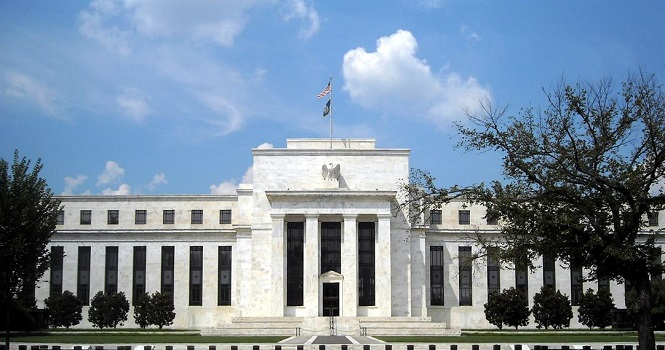Fed poised for preemptive 25 bps cut; all eyes on Powell: Analysts

Federal Reserve headquarters
The US Federal Reserve concludes its policy meeting later today, Sept. 17, with markets widely expecting a 25-basis-point (bps) rate cut.
Analysts say the move would be largely preventive, reflecting divisions within the committee over the need for such an action, alongside continued political pressure from President Donald Trump for faster easing.
Analysts polled by Argaam expect the Fed to opt for a modest, “preemptive” cut while maintaining a cautious, data-dependent stance. They noted that market reaction will hinge largely on the updated “dot plot” and the tone of Fed Chair Jerome Powell during the press conference.
Why 25 bps only?

Ahmed Azzam, Head of Research and Market Analysis at Equiti Group
Ahmed Azzam, Head of Research and Market Analysis at Equiti Group, described a 25-bps cut as the “prudent decision,” noting that economic indicators do not justify a move of 50 bps at once.
Inflation remains above target but not alarming, as Powell highlighted in Jackson Hole. However, the recent data shows mixed signals, such as softness in the labor market but stronger-than-expected retail sales and industrial production in August.
Azzam added that a 50-bps cut could be seen as a panic or political submission, undermining the Fed’s credibility and narrowing its room for maneuver in upcoming meetings.
By contrast, a 25-bps cut achieves two main goals: responding to labor market dynamics and maintaining policy credibility, while keeping the door open for possible moves in October and December meetings.
On economic activity, Azzam noted that the data shows relative resilience in consumption and the industrial sector, against a gradual labor market slowdown reflected in higher unemployment and weaker hiring. This suggests that there is neither enough disinflation to support a daring move nor a decline in demand to support a significant cut.

Michael Brown, Senior Research Strategist at Pepperstone
Michael Brown, Senior Research Strategist at Pepperstone, said markets have already priced in a 25-bps cut, though full consensus within the committee is improbable. He expects some members to advocate for a larger cut, while others may prefer to hold steady.
New Fed’s board of governors member Stephan Miran could argue for a 50-bps cut, while Bowman and Waller may favor a more dovish stance. By contrast, regional Fed presidents from St. Louis and Kansas City may argue for a pause.
Brown added that the policy statement will likely reiterate data dependence but could hint at “further easing” rather than just “adjustments,” reinforcing the dovish tilt.
Milad Azar, Financial Markets Analyst at XTB MENA, said futures and surveys show near-unanimous expectations for a 25-bps cut. The key, however, is whether the move will be framed as part of a broader easing cycle.
Dot plot: Pricing decisive factor
According to Azzam, the updated economic projections are likely to keep the median outlook at a total of 50 bps in cuts for 2024, with divergence among members over whether this should mean two or three moves.
He emphasized that the market will be watching how cuts are distributed through 2026–2027 because even a small dovish stance might be interpreted as a pledge to more easing if inflation continues to fall and labor conditions weaken.
The official statement and Powell’s press conference will stress data dependence while framing the cut as a “preemptive measure.” However, signaling a “cycle of rate cuts” could lead markets to price in faster easing than the Fed intends.
Azzam noted that today’s meeting comes against an unusual backdrop of institutional noise: Stephan Miran’s confirmation to the Board of Governors, Lisa Cook’s attendance following a court ruling, and ongoing debate over Fed leadership. These dynamics could amplify dissenting voices and push toward a consensus compromise of a limited 25-bps cut.
Brown, for his part, expects the dot plot to reflect 50 bps of cuts in 2024 and another 50 bps in 2026, while the 2025 median would require at least eight members to shift their stance to change. He said Powell will likely downplay the dot plot, stressing it is not a binding commitment.
Azar warned that the absence of clear signals for further cuts could be seen as a “hawkish cut,” while projections for two or more cuts in 2025 would be read as dovish, supporting risk appetite.
Market implications
Azzam said the base-case market reaction to a 25 bps cut with a cautious tone would be a mild 5–10 bps decline in two-year Treasury yields and limited curve flattening.
The dollar would likely remain broadly stable without aggressive repricing of the easing path; equities could see selective gains led by defensive sectors banks may benefit from the exclusion of a 50 bps cut scenario. Moreover, gold could edge higher as a hedge without a sharp dollar drop.
He added that a more dovish scenario—a 25 bps cut combined with clear signals of an easing cycle—could push short-term yields down 10–20 bps, steepen the curve, weaken the dollar more broadly, boost commodity-linked and emerging market currencies, and give momentum to growth and cyclical stocks, while banks may come under pressure. Gold would likely gain stronger upside in this case, bolstered by lower US currency.
The less likely 50-bps scenario, Azzam warned, could spark sharp volatility, with an initial bond rally and weaker dollar, followed by a reassessment if evidence did not support the move. Equities could jump at first but reverse if the cut is interpreted as a sign of economic stress, while gold could surge significantly.

Milad Azar, Financial Markets Analyst at XTB MENA
Azar added that a “hawkish cut” could weigh on equities, especially those trading near record highs, if seen as precautionary without a clear easing path. Markets will be especially sensitive to the distribution of cuts in the dot plot, which will shape risk appetite.
Brown cautioned that markets are already pricing in 75 bps of cuts by year-end and a terminal rate of 3% by mid-2026.
This sets a high bar for investor expectations that the Fed may be unable to meet. He warned that any cut falling short of these expectations, or a more cautious tone from Powell, could trigger a repricing of the yield curve and put pressure on risk assets.
Comments {{getCommentCount()}}
Be the first to comment
رد{{comment.DisplayName}} على {{getCommenterName(comment.ParentThreadID)}}
{{comment.DisplayName}}

{{comment.ElapsedTime}}







Comments Analysis: